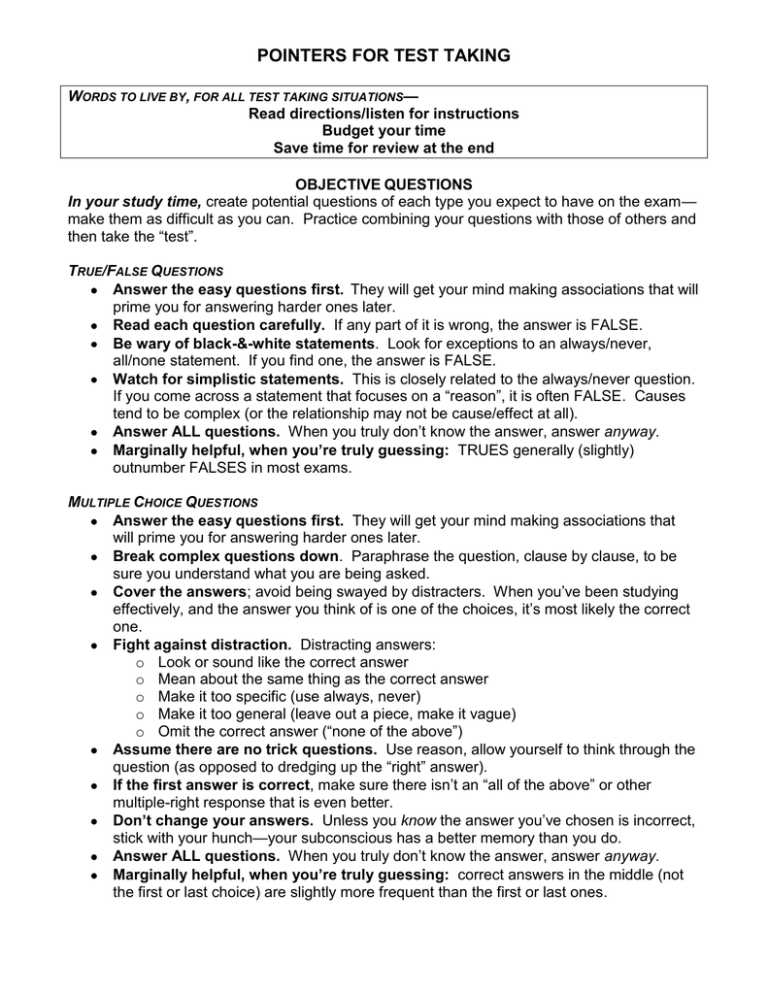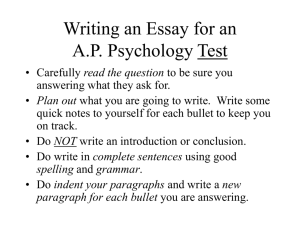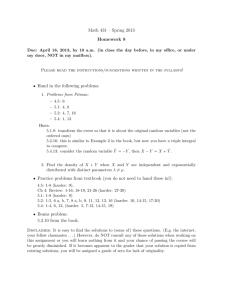POINTERS FOR TEST TAKING
advertisement

POINTERS FOR TEST TAKING WORDS TO LIVE BY, FOR ALL TEST TAKING SITUATIONS— Read directions/listen for instructions Budget your time Save time for review at the end OBJECTIVE QUESTIONS In your study time, create potential questions of each type you expect to have on the exam— make them as difficult as you can. Practice combining your questions with those of others and then take the “test”. TRUE/FALSE QUESTIONS Answer the easy questions first. They will get your mind making associations that will prime you for answering harder ones later. Read each question carefully. If any part of it is wrong, the answer is FALSE. Be wary of black-&-white statements. Look for exceptions to an always/never, all/none statement. If you find one, the answer is FALSE. Watch for simplistic statements. This is closely related to the always/never question. If you come across a statement that focuses on a “reason”, it is often FALSE. Causes tend to be complex (or the relationship may not be cause/effect at all). Answer ALL questions. When you truly don’t know the answer, answer anyway. Marginally helpful, when you’re truly guessing: TRUES generally (slightly) outnumber FALSES in most exams. MULTIPLE CHOICE QUESTIONS Answer the easy questions first. They will get your mind making associations that will prime you for answering harder ones later. Break complex questions down. Paraphrase the question, clause by clause, to be sure you understand what you are being asked. Cover the answers; avoid being swayed by distracters. When you’ve been studying effectively, and the answer you think of is one of the choices, it’s most likely the correct one. Fight against distraction. Distracting answers: o Look or sound like the correct answer o Mean about the same thing as the correct answer o Make it too specific (use always, never) o Make it too general (leave out a piece, make it vague) o Omit the correct answer (“none of the above”) Assume there are no trick questions. Use reason, allow yourself to think through the question (as opposed to dredging up the “right” answer). If the first answer is correct, make sure there isn’t an “all of the above” or other multiple-right response that is even better. Don’t change your answers. Unless you know the answer you’ve chosen is incorrect, stick with your hunch—your subconscious has a better memory than you do. Answer ALL questions. When you truly don’t know the answer, answer anyway. Marginally helpful, when you’re truly guessing: correct answers in the middle (not the first or last choice) are slightly more frequent than the first or last ones. POINTERS FOR TEST TAKING MATCHING QUESTIONS Look for the relationship between the two columns. What is the reason for matching one with the other? Answer the easy questions first. They will get your mind making associations that will prime you for answering harder ones later. Start with the longer column. You will be able to zero in more quickly on the target column if you are looking at less material. Keep track of your choices. Mark out the choices that have been used in both columns, so you don’t waste time reading them again. SHORT ANSWER/FILL-IN-THE-BLANK QUESTIONS Answer the easy questions first. They will get your mind making associations that will prime you for answering harder ones later. Focus on key words/terms in your study. Groups of terms (parts of a whole, such as historical periods or steps in a system) should be studied as a group; if order is important, an acronym may be useful in ensuring you get the order right. ESSAY QUESTIONS In your study time, create possible questions. Outline your answers; this allows you to move from memorization to thinking conceptually. In your outline, include key terms/phrases. As you study, practice talking through your response. Skim the questions. Particularly if you are to choose from a list, rather than answer every question, get a sense of which question(s) you feel most comfortable writing about. Jot down key terms that come to mind as you do so. Pay attention to the question. Read carefully, paraphrasing as you go and underlining main points. If it’s a complex question, number the pieces that you will need to respond to. Structure your answer. Briefly outline your response before writing, and refer to the question before jumping into the actual writing—are you addressing all parts of the question? Make your point quickly. Particularly for a long essay, make your introduction brief and concrete, highlighting your key point(s). Don’t take chances on being too specific. If you don’t remember a date exactly, make a more general statement (one that’s as specific as you can get comfortably).







